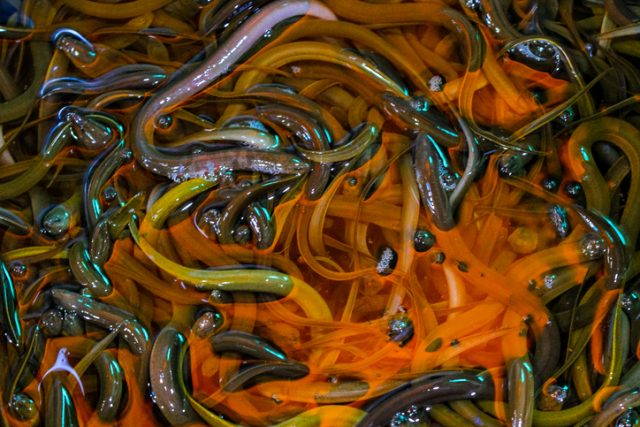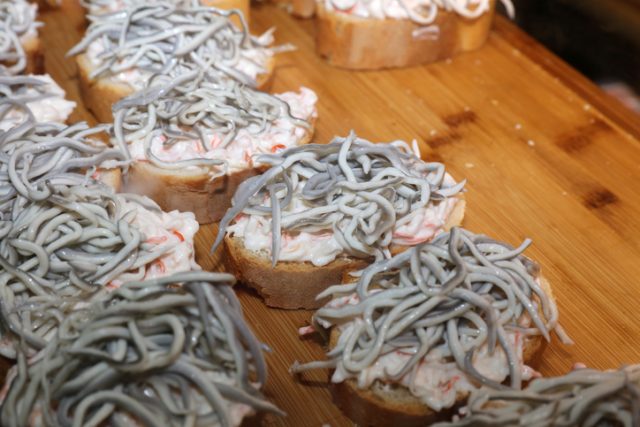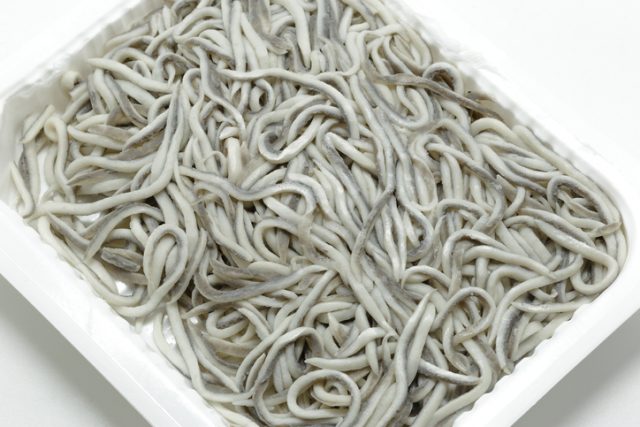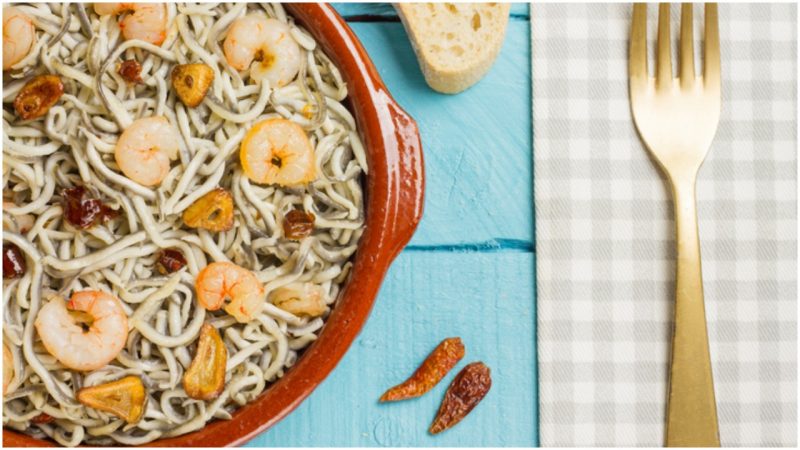How can something slimy, small, and tasteless be such an expensive menu item?
In Spain, baby eels, transparent until cooked, at which point they turn white, fetch nearly $550 per pound when fresh (that is, 1,000 euro per kilo). Frozen and shipped to the U.S., the tiny treasures cost up to $800 per pound.
Angulas, as the baby European eels are called in Spanish, are bland, hence they are traditionally sautéed in olive oil with plenty of garlic and hot pepper. Angulas once served as fodder for chicken and pigs. So how did the worm-like creature slither from trough to table?
Adult eels migrate thousands of miles up Spain’s coast to the Sargasso Sea, where they spawn, lay eggs, and die. Baby eels spend two to three years drifting back to Spain on Gulf Stream currents. Once back to Spain’s Atlantic shores, they are dredged from river mouths and turned into a delicacy Spaniards liken to caviar. Baby eel season starts in November and lasts a couple of months.

The first batch of baby eels to go up for auction is historically the priciest, and it’s a coup for whoever wins them—and pays the hefty price. In 2016, the first lot weighed 1.25 kilos (or 2.75 pounds), for which a restaurateur paid 5,500 euros (or $6,780 dollars), according to the BBC.
“It was a bit of marketing for my restaurant and also an homage to the fisherman,” José Gonzalo Hevia, owner of Casa Tista restaurant in Asturias, Spain, told the BBC. Gonzalo Hevia was once an angula fisherman himself. “The atmosphere at the auction is very exciting. It’s a big media event. The next day, the name of my restaurant was in every newspaper and on every TV station.”
Prepared a la Bilbaina, angulas are about 3 inches long and look a little like spaghetti (although their tiny black eyes are disconcerting). They are considered so delicate that they are served in a special clay bowl and diners are told to eat the dish using a wooden fork, so as not to disturb the flavor with steel. In the Basque country, angulas are traditionally served on Christmas Eve, New Year’s Day, and the Day of San Sebastian, January 20th.

Angulas were once plentiful and cheap in northern Spain, which explains why they were tossed in troughs and graced the tables of the working class in the 1950s and ’60s. During the 1970s, fancy restaurants put them on menus, which made angulas a fashionable high-low concept dish. Increased demand, overfishing, and changes in ocean temperatures diminished supplies, causing prices to skyrocket. Eels are now an endangered species, causing some conscientious American foodies to question the ethics of consuming baby eels.
In 1991, a company created an imitation angula (similar to imitation crab popular in the U.S.), made of Japanese surimi, a paste of processed fish, pressed into the familiar wormy shape (without the beady black eyes). Called gulas, they can be found in grocery stores and in pintxo bars across Spain. But like mock crab, gulas are just an approximation of the real thing.

Today in upscale Basque restaurants, angulas appear on the menu as an appetizer for 80 euros (just under $100). Which for a certain class of diner—rich, status-seeking, or just plain food-obsessed—isn’t entirely unreasonable or out of reach. Especially compared with how much people spend for a rare and coveted bottle of wine.
Whether you’re held back by your conscience, your wallet, or the thought of eating worms, you can approximate traditional angulas with garlic, hot pepper, and one inexpensive and convenient substitution.
“You can make the same dish but with using spaghetti,” Gonzalo Hevia told the BBC, only half-joking. He retired from the restaurant business in 2017. “We call it Poor Man’s angulas.”
E.L. Hamilton has written about pop culture for a variety of magazines and newspapers, including Rolling Stone, Seventeen, Cosmopolitan, the New York Post and the New York Daily News. She lives in central New Jersey, just west of New York City.
